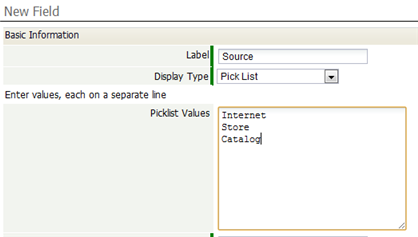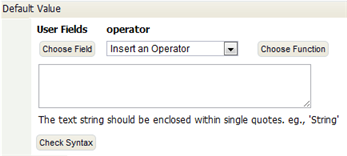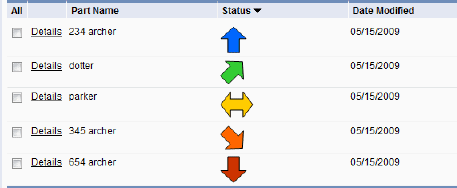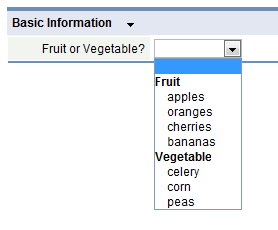Difference between revisions of "Working with Picklists"
imported>Aeric |
imported>Aeric |
||
| Line 19: | Line 19: | ||
:*'''Always Required -''' A selection must be made when adding or updating a record. | :*'''Always Required -''' A selection must be made when adding or updating a record. | ||
:*'''Field Name -''' Automatically created by the system (but you can change it here) | :*'''Field Name -''' Automatically created by the system (but you can change it here) | ||
{{:Common:Enumerated Field Sections}} | |||
{{: | |||
<noinclude> | <noinclude> | ||
===Specify a Default Value=== | ===Specify a Default Value=== | ||
Revision as of 19:52, 24 January 2012
A Picklist is a field that can contain a list of values. It appears as a dropdown list when displayed.
Create a Picklist
- Click Designer > Data > Objects > {object} > Fields
- Click [New Field]
- Provide the information in the sections below.
- Click [Save]
The field is added, and the field-definition is shown. You can now Manage and Reorder Values to specify display text and colors, images, and grouping labels.
Basic Information
- Specify the basic characteristics of the field:
- Label - The text that appears as the field name
- Display Type - Picklist
- Picklist Values - For a simple Picklist that returns the same values it displays, with no special colors, images, or groups for the display values, you can simply enter the values, as shown here:
- Otherwise, wait until the Picklist has been created, then Manage and Reorder Values.
- Maximum Storage Length - The String length of the longest value in the list.
- Use First Value as Default - Otherwise, the field is initially empty.
- Sort List Alphabetically - Otherwise, you manually arrange the order.
- Always Required - A selection must be made when adding or updating a record.
- Field Name - Automatically created by the system (but you can change it here)
Display Attributes
- Determine where the field is displayed in the default form, and whether or not the field is required when adding or updating a record.
Default Value
In general, the default value you specify will be a simple String. For example: 'rush'. But it is also possible to select functions and specify arguments, creating a formula expression that returns the default value.
- Considerations
-
- The default value must resolve to the value of an entry in the list of enumerated items (not a label).
- If the value resolves to a string which is not in the list of the enumerated items, it is as though no default were specified. Nothing is pre-selected in the Enumerated Field.
Role-Based Field Visibility
Set Field Visibility based on Role. This option defines the Roles that are permitted to view and use the designated Field. Available field settings include:
- Visible
- Read-Only
- Hidden
This control is created when a Field is Added to an object.
- Learn more: Visibility Controls
- Considerations
- When a field is added to a Form, the field visibility control is set to Visible by default
- When a new role is added, that role receives Visibility rights to all the fields across all the objects
- When this control is specified for a field, it will be enforced in the Field Audit Log; This means that the user Role determines whether a record is visible in an Audit Log
Description Information
- Include a description of the field and its use. This information is only visible to users with rights to customize this field.
Specify a Default Value
Default Value for an Enumerated Field
Manage and Reorder Values
Specify Display Text, Colors, Images, and Grouping Labels
The Enumerated Values section of the field-definition page lets you specify display-text, colors, images, and grouping labels, as well as the values returned by user selections:
Click [Manage Values] to specify display text, color, images, and grouping labels.
- Fields
- Alphanumeric Characters are allowed in labels and values, including special characters (+ / ' - _) and spaces.
- Display Label - The label to display in the list.
- Value - The actual value that is stored in a record (or returned to a program) when this item is chosen from the list.
- Image - Specify an image to display (learn more below)
- Show only Image in View mode - Whether to show the image alone, or together with the label.
- Font color - Foreground color
- Background color - Color of the area in which the text is displayed
- Use Label for grouping - The specified label becomes a heading in the list, rather than a selectable value (learn more below)
- Specify images
- To specify images, first upload them to the platform as Documents. This example shows records that were created after selecting such images from a picklist:
- Specify grouping labels
- Click Use Label for Grouping to use a label as a group indicator, rather than making it a selection the user can click.
- This option is useful when a picklist is long, and can be organized into groups.
- Considerations
-
- The Use Label for grouping option is available only for Picklists
- After the Use Label for grouping option is selected, the Sort List Alphabetically option is reset to No (otherwise, the label won't be helpful).
- If the Use Label for grouping option is selected, the enumerated values are not available for dependent field associations.
Reorder Values
In the Enumerated Values section of the field-definition page, click [Reorder Values] to change the order in which the values appear:






